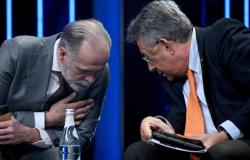In the case of Europe, the concept of sovereignty is both more and less extensive than the usual concept of national sovereignty. It is more extensive because it concerns a group of countries that share the same sovereignty. It is less extensive because it concerns only some aspects of state sovereignty. This makes the question of defining European sovereignty particularly complex because it concerns a process in continuous transition, which requires the consensus of numerous countries, with national preferences and approaches that are often different and not immediately combinable”. Thus write, in their book published by Laterza, Paolo Guerrieri, now visiting Professor at the Paris School of International Affairs, Sciences Po (Paris) and Pier Carlo Padoan, former minister of economy and president of Unicredit. A volume whose title is enough to irritate the new right: “Sovereign Europe”.
Complex? No, European sovereignty is much simpler than you think for Matteo Salvini. He doesn’t believe it. It is not clear to what extent he believes in national sovereignty (and not regional, municipal or local in general), much less does he believe that it can become the particular declination of a common sovereignty. For him, Brussels does not and will never deal with serious things, but only with making life difficult for fishermen and beachgoers. He forgets the Pnrr and the 190 billion European euros that he himself as infrastructure minister is largely called upon to use in the best possible way. On Sunday 2 June he dropped his mask, also attacking President Mattarella. But the pars construens of Salvini’s thought is still to be explored, probably to be built. That of Guerrieri and Padoan, however, is an entire construction, part Gothic cathedral, part Baroque palace, as in the tradition of a culture that has always been more homogeneous than one might think, based on that exchange of men, values, thought and art which, when not interrupted by the desire for power and barbaric impulses, represented the best of Europe.
We have not mentioned Gothic or Baroque architecture at random, but because they mark two key eras of old Europe and took time, just like building the new Europe. Guerrieri and Padoan, moreover, did not write for the elections of 8 and 9 June, they immediately focused on the aftermath. Theirs is a manual or rather a “reference book” for the next commission. Its contents overlap with the Letta report on the single market and with the work on competitiveness that Mario Draghi will deliver in July. Just take a look at its structure. Chapter one: “Europe’s role in the global economy”; then “Growth and sustainability: recovering lost ground”; “The environmental transition and Europe’s competitiveness”; “From monetary integration to economic union”; “Europe in the new world”; finally “Towards European sovereignty”. It’s a shame that European defense is a little diluted and no more space is given to the return of war in a continent that seems to be falling back into its dark past.
The final chapter begins with the relaunch of growth, a key step without which the entire framework cannot be held. Europe lost much ground to the United States and China in the first two decades of this century. Without a return to solid development there is no possibility of becoming a “global player”. But without economic growth there is no security either. The major critical point is that both require different governance. The issue to be resolved is undoubtedly the unanimous vote to adopt the majority criterion. However, it is not enough. We need more common resources and an institutional system that makes the EU an increasingly integrated body. The relationship between the council of member states, the commission and parliament, therefore, also needs to be reviewed.
Are we therefore entering the Superstate? No. Of course the two authors fit into the great federalist trend, but they underline that plural Europe is a value, not an obstacle, as long as its functioning changes. Guerrieri and Padoan promptly analyze the various proposals on the table, from the concentric circle model to that of the clubs that they like best: “These would be – they write – clubs represented by European policies and public goods that are partially excludable, and therefore not necessarily created through a generalized integration process that always involves all member countries. Participating countries would be free to choose to participate in some clubs and ignore others.”
A new enlargement seems inevitable, think of Ukraine, but it must be accompanied by further reforms and a revision of the treaties. Long times and perilous paths, therefore, however “the greatest risk is the status quo. There would probably be a setback in European integration, the limits of which cannot be defined today but which would have the effect of increasing fragmentation and the weakening of governance. This scenario, in the presence of two global players such as China and the United States, could lead to a growing marginalization of the Union up to a definitive collapse of the European plan”. It is the final message. In a week we will begin to see if it will be collected, how and by whom.






